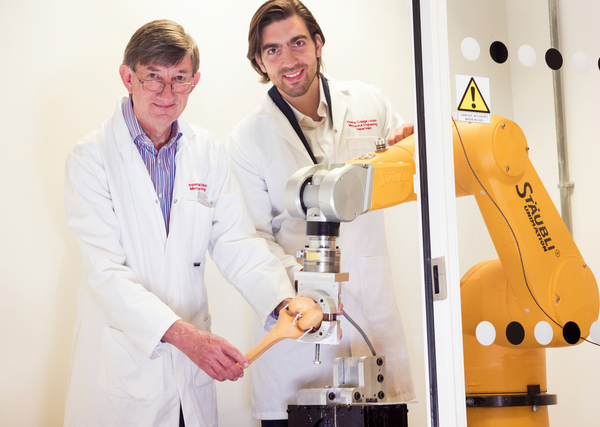Advances in materials and techniques are restoring damaged body parts to full function. Report on Orthonika by Liam Drew
https://www.nature.com/articles/545S21a
For Orthonika, 2017 is a year of refinement. The company will put its prototype knee-meniscus replacement through its paces inside donated knees attached to robots that mimic the forces that normally act on this joint. The goal is to catch any design flaws before the company trials the synthetic meniscus in sheep next year.
The robots are found in the lab of Andrew Amis, an orthopaedic biomechanics specialist at Imperial College London and co-founder of Orthonika. For now, Orthonika is a virtual company; its six directors remotely coordinate the activities of a team of suppliers, designers and manufacturers across Europe and the United States. “One day, we'll have to bite the bullet and start paying rent,” says co-founder Dominique Kleyn, who has a background in business development and used to work for Imperial Innovations, the technology-transfer office for Imperial. The directors are now looking for partners to conduct next year's preclinical trials.
Sandwiched between the tibia and femur, the knee meniscus is a C-shaped piece of cartilage that acts like a shock absorber, distributing forces across the knee. Although menisci seem to be perfect candidates for 3D-printed replacements, 30 years of failed attempts to make functioning synthetic versions show that it's not that easy.
When knee menisci tear — typically through traumatic twisting injuries in younger people and following degeneration in older people — little can be done to repair the tissue. A torn meniscus that is causing pain or interfering with knee function is simply removed, but this greatly increases the risk of osteoarthritis.
Amis, whose academic work has led to the development of prosthetic elbows and artificial ligaments, became interested in making replacement menisci about a decade ago. He and another Orthonika co-founder, Justin Cobb, an orthopaedic surgeon at Imperial, saw it as an “obvious thing to tackle”.
In June 2014, having come up with a promising meniscus design and, crucially, a way of attaching the device to the tibia, Amis and Cobb sat down with entrepreneurs from Sierra MedTech, a medical-technology start-up based in the United Kingdom. Orthonika was formed in December of that year.
Sierra MedTech had an innovative approach to constructing orthopaedic implants. The polymer materials that it used were not new, but the company was combining them in a composite that replicated the structure and function of musculoskeletal tissues.
Change of direction
Sierra MedTech's directors — including Kleyn and co-founder Mario Alberto Accardi, a venture capitalist with a PhD from Imperial who had helped to develop the new composite — thought that their invention had numerous applications in orthopaedics. But after surveying clinicians, they focused on replacement menisci. Removal of torn menisci is one of the most commonly performed orthopaedic procedures in Europe and the United States. Apart from expensive and logistically difficult transplants, there are no viable replacement options. With the right material but no design, they turned to Amis and Cobb at Imperial.
Amis says he and Cobb were already looking for commercial partners, but what Sierra MedTech proposed was altogether different from how Amis's earlier research had been developed. Previously, he had taken projects through to the patent-filing stage with the university and relinquished control of the work when the university licensed the patent to large companies. To develop early ideas, he had always secured grant funding. But here was a tiny company wanting to partner early in the development process and to fund it and help steer it. “The idea of Mario and his team coming along and saying, 'We know how to start and grow companies and raise capital', seemed interesting,” says Amis. “For me, it's a completely strange and new world.”
Accardi describes finding a group of seed investors to “believe in us and the project, and to be willing to take the risk as the key step in establishing Orthonika as a new company”. That first £150,000 (US$192,000) of funding gave the company credibility with the university. “That's the life of a biotech,” says Kleyn. “You take a little step and that enables you to take a bigger step.”
That next step was Orthonika's toughest challenge so far: negotiating an intellectual-property deal with Imperial Innovations, which held the patents arising from Amis's work. It took several months to reach an arrangement that satisfied Imperial and left Orthonika with enough flexibility to be confident that it could attract further investment.
“We had then to draw a wider team around us,” says Kleyn, “people who'd help with design work, testing, manufacturing and assembly. It was about finding the right fit.” Achieving this has led to the development of the company's prototype, which is currently undergoing testing in Amis's lab.
“There are very few opportunities left in medical technology and orthopaedics that are more or less greenfield with such a high unmet clinical need,” says Accardi, “so we know if we can get this right, there will be a market for it.”
Orthonika secured a £260,000 grant from Innovate UK in February, and another seed investor matched the investment. These funds cover this year's testing and the initial animal trials. If preclinical testing goes to plan, the company hopes to insert its knee meniscus into a small number of people within four years. If this trial is promising, the co-founders hope that the company will then be acquired by a large orthopaedic device firm.
